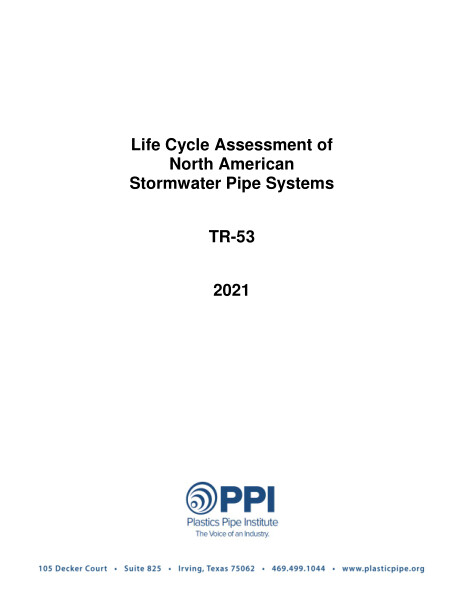Plastics Pipe Institute Life Cycle Assessment of North American Stormwater Pipe Systems
Filename:
Plastics Pipe Institute Life Cycle Assessment of North American Stormwater Pipe Systems.pdf

Plastics Pipe Institute funded a research project titled, “Life Cycle Assessment of North American Municipal Stormwater Pipe Systems,” which was performed by Franklin Associates, a division of ERG completed April 2020.
The purpose of this technical note is to summarize the scope and methodology of the research program and highlight the results, which are the environmental impacts of high-density polyethylene (HDPE) and alternative stormwater pipe systems. This information will assist PPI members in communicating the environmental impacts of HDPE pipe systems. It will also provide specifiers, owners, and others with useful information when selecting which technology to employ for stormwater pipe systems.
The LCA methodology involves goal and scope definition, life-cycle inventory (LCI) analysis, life-cycle impact assessment and life-cycle interpretation. From this, goal and scope definition is determined. Allocation procedures, assumptions, comparative assertion, peer-review, life cycle inventory analysis, impact assessment, interpretation and results are detailed.
Tables shown are Results for 24-in.-diameter Stormwater Pipe for Leave in Place at End-of-Life, Comparative Results with HDPE baseline for 24-in.-diameter Stormwater Pipe for Leave in Place at End-of-Life, Comparative Results with HDPE with 50% recycled content baseline for 24-in.-diameter Stormwater Pipe for Leave in Place at End-of-Life.
Global warming, acidification, eutrophication, ozone depletion, smog formation, total energy demand, solid waste, water consumption potential are discussed in detail.
Sensitivity analyses are used to verify that assumptions made during the LCA do not significantly change the results. For this study, sensitivity analyses were run for three assumptions: those related to pipe weights, steel reinforcement content in the reinforced concrete pipe, and average transportation distances for reinforced concrete pipe.
A sensitivity analysis is included on pipe weight because there can be weight variations for pipe produced by different manufacturers. Overall, the pipe weight sensitivities do not show notable changes in the comparative conclusions for baseline weight pipes.
The reinforcing steel content of reinforced concrete pipe was modeled based on industry data per metric tonne of pipe. If the reinforced concrete pipe is modeled with the lower steel content, only a few comparative conclusions for HDPE and reinforced concrete pipe are affected.
